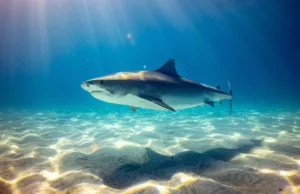Hawaii, a paradise of tropical beauty and stunning marine life, offers a unique opportunity for adventurous souls to swim with sharks. As a nature enthusiast or an adrenaline seeker, you may wonder what kind of sharks you can encounter in the crystal-clear waters surrounding the Hawaiian Islands.
In this guide, we will delve into the captivating world of Hawaii’s shark species, exploring their characteristics, behavior, and the remarkable experiences they offer to those brave enough to swim alongside them. Join us as we unlock the secrets of these magnificent creatures and discover the ultimate shark encounter destinations in Hawaii.
The Tiger Shark
Let’s begin our exploration with one of the most awe-inspiring creatures that inhabit the Hawaiian waters—the tiger shark. Known for its distinctive appearance and commanding presence, the tiger shark can reach lengths of up to 18 feet and weigh up to 2,000 pounds. These apex predators are easily recognized by their powerful bodies, dark vertical stripes, and formidable jaws lined with sharp, serrated teeth.
Encountering a tiger shark while swimming in Hawaii is a thrilling and humbling experience. Although they are known to be curious and inquisitive creatures, their interactions with humans are typically non-aggressive. Diving enthusiasts can embark on guided tours to observe these magnificent creatures up close, providing valuable insights into their behavior and fostering a deeper understanding of their ecological importance.
The Hammerhead Shark
Another remarkable species that grace the Hawaiian waters is the hammerhead shark. Distinguished by their unique hammer-shaped heads, these sharks possess incredible sensory capabilities, using their wide-set eyes to provide a panoramic view and detect prey more efficiently.
The main species of hammerhead sharks found around Hawaii is the scalloped hammerhead. These sleek predators exhibit a graceful yet powerful swimming style, making them a sight to behold for those fortunate enough to encounter them underwater. While swimming with hammerhead sharks can be an exhilarating experience, it’s important to note that such encounters are usually arranged with professional guides who prioritize safety and environmental conservation.
The Whitetip Reef Shark
Among the tropical reefs surrounding Hawaii, the whitetip reef shark reigns as a symbol of beauty and serenity. Recognizable by the distinct white tips on their dorsal and caudal fins, these sharks are known for their nocturnal behavior, preferring to rest in caves or beneath coral ledges during the day and becoming more active at night.
Swimming alongside these graceful creatures offers a unique opportunity to observe their tranquil movements and witness their interactions with the vibrant reef ecosystem. While the whitetip reef shark generally poses little threat to humans, it’s essential to respect their space and approach them with caution to ensure a safe and responsible encounter. As you might expect, these sharks are most typically found around Hawaii’s sprawling coral reefs, where food is abundant.
The Galapagos Shark
Venturing deeper into the waters of Hawaii, you can encounter the Galapagos shark. These sharks, named after the Galapagos Islands but also found in the Pacific, are known for their playful and curious nature. With a robust build and a distinctive dark grey coloration, they can grow up to 12 feet in length. Swimming with Galapagos sharks allows you to witness their dynamic behaviors, from graceful swimming patterns to investigating their surroundings with keen interest.
Despite their size, Galapagos sharks are generally docile and rarely pose a threat to humans. However, as with any shark encounter, it is important to approach them with respect and follow the guidance of experienced guides to ensure a safe and controlled experience.
The Whale Shark
While not as commonly encountered as other shark species in Hawaii, the magnificent whale shark occasionally graces the waters surrounding the islands. As the largest fish in the world, these gentle giants can reach lengths of up to 38 feet long and weigh several tons. Despite their massive size, they have a placid nature, feeding primarily on plankton and small fish.
Swimming alongside a whale shark is a truly awe-inspiring experience. These majestic creatures move gracefully through the water, their distinctive patterns and massive mouths capturing the imagination of all who encounter them. It is important to note that whale shark encounters in Hawaii are rare and heavily regulated to protect the species. Strict guidelines and responsible eco-tourism practices ensure that these encounters are conducted with utmost care for the well-being of these magnificent animals.
The Sandbar Shark
Among the various shark species that inhabit Hawaiian waters, the sandbar shark stands out for its elegance and distinctive appearance. Also known as the brown shark or the thickskin shark, the sandbar shark is characterized by its tall, triangular dorsal fin and sleek, streamlined body that allows it to move effortlessly through the ocean.
Sandbar sharks are commonly found in the shallow coastal waters of Hawaii, particularly around sandy beaches, estuaries, and inlets. They typically grow to lengths of 6 feet long and have a gray to brownish coloration, which helps them blend in with the sandy seafloor.
Swimming with sandbar sharks offers a fascinating opportunity to observe their natural behavior. These sharks are known for their calm and non-aggressive nature towards humans, making them a popular choice for shark encounters. While they possess sharp teeth, they primarily feed on small fish, rays, and crustaceans, rather than larger marine mammals. To experience a sandbar shark encounter, you can join a guided snorkeling or diving excursion led by experienced professionals. These tours provide a safe and controlled environment where you can appreciate the beauty and grace of these magnificent creatures up close.
How does swimming with sharks work?
Swimming with sharks is typically done through guided tours led by professional operators who specialize in shark encounters. These operators have extensive knowledge about the behavior and habits of different shark species, ensuring a safe and informative experience for participants. Shark encounters take place in carefully selected locations known for their shark populations. These locations are often in close proximity to areas where sharks naturally gather, such as feeding grounds, coral reefs, or specific habitats favored by the target shark species.
Before entering the water, participants receive comprehensive safety briefings from the guides. They are educated on shark behavior, proper conduct, and safety protocols. Participants are also provided with appropriate snorkeling or diving equipment, including masks, snorkels, fins, and wetsuits if necessary. Responsible operators prioritize the well-being and conservation of sharks and their habitats. They emphasize the importance of environmental awareness and respect for marine ecosystems. Guides educate participants about the significance of sharks in the ecosystem, their role as apex predators, and the need for their conservation.
During the shark encounter, participants are guided to maintain a safe distance from the sharks and to avoid any sudden movements that may startle or provoke them. Guides ensure that the interactions are non-intrusive and do not disrupt the natural behavior of the sharks. Most shark encounters involve swimming with non-aggressive species, such as tiger sharks, hammerhead sharks, whitetip reef sharks, sandbar sharks, or other species known for their relatively calm nature when encountering humans. These species are chosen for their predictable behavior and low risk to participants.
Overall, shark tours are a safe and enjoyable way to get in touch with nature. Shark diving is well-regarded as safe and has quickly become a popular way to explore underwater.
Is swimming with sharks safe?
It’s very safe to swim with sharks in the right circumstances, contrary to popular belief. While you do have to follow some basic safety precautions, swimming with sharks can be a safe and unforgettable experience.
Is swimming with sharks scary?
Depending on how comfortable you are in the water, swimming with sharks can be scary for some people. If you’re not super comfortable with water or wildlife, swimming with sharks could be an unsettling experience for you. However, it’s a great way to learn about wildlife and become more confident in many areas of life.
Swimming with Sharks Can Be Perfectly Safe
Hawaii’s crystal-clear waters are home to a diverse array of shark species, each with its own unique characteristics and allure. From the powerful and awe-inspiring tiger shark to the graceful and enigmatic whale shark, swimming alongside these magnificent creatures offers an unforgettable experience for nature enthusiasts and adventure seekers alike. Whether you choose to embark on a guided tour or observe these sharks from a safe distance, it is essential to prioritize their well-being and conservation. By fostering a deeper understanding and appreciation for these apex predators, we can contribute to their protection and ensure that future generations can continue to marvel at their beauty in the Hawaiian waters.
What It’s Like To Swim With Sharks With Ocean Outfitters
Mainly we swim with Galapagos sharks which are typically in the 6-10ft range, with big ones getting up to 12ft. They are a schooling type of shark that is very docile in the area we swim with them due to the last 75 years of being fed by the crabbing industry that takes place in the same zone. We also see sandbar sharks pretty regularly which are generally in the 3-6ft range, with big ones getting up to 8ft. Galapagos sharks typically will cruise around with us in the water, moving pretty slow for the most part, while sandbars move a lot quicker and stay farther away. Although Galaps and Sandies are the only ones we expect to see on a regular basis, we also get visits from a few other kinds of sharks. Occasionally we see Scalloped Hammerheads, which have a breeding ground in the Kaiaka Bay.
We also see Tiger sharks (mainly during the summer), and every once in a while, we spot Oceanic black tips, although they typically stay pretty deep and far away from us. People associate sharks as aggressive predators, but it is important to note that while humans kill over 100 million sharks per year (for sport, shark fin soup, and cosmetics), they only kill an average of 7 people per year. Sharks (especially the ones we swim with) have no interest in eating people. They are not attracted to human blood and come hang out with us mainly out of curiosity.
If you’d like to learn more or experience the fun, check out our bookings or give us a call at Ocean Outfitters in Haleiwa, HI – 1 (808) 400-7905! Thank you for reading, and we hope to see you soon!



